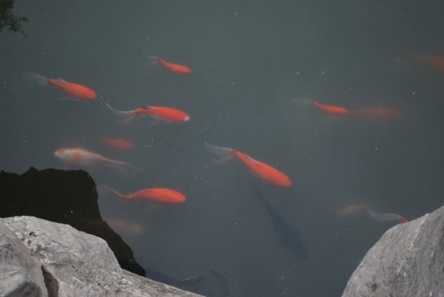 It was a quiet night, but then most nights were quiet in my tree-lined back yard. Still, murder had been done, and nearly a dozen lives ruthlessly ended. The little goldfish had been happily swimming in my small ponds for two years, and suddenly they were gone. Justice–or at least prevention–had to be ensured. The game, as they say, was afoot.
It was a quiet night, but then most nights were quiet in my tree-lined back yard. Still, murder had been done, and nearly a dozen lives ruthlessly ended. The little goldfish had been happily swimming in my small ponds for two years, and suddenly they were gone. Justice–or at least prevention–had to be ensured. The game, as they say, was afoot.
I had only myself to blame, really. Because of my limited space, my first pond had been simple. When I dug out a large shrub with shallow, spreading roots, I used the space for a shallow, spreading pond. It turned out that it was not a good shape for a pond–unless you were a predator.
The second pond was better, with a shelf and a narrow deeper section. The third pond was made from an old inflatable hot tub. The straight sides and three-foot-depth made the goldfish less likely to become someone’s snack. They survived.

Initially, I got the goldfish to eat mosquito larvae, and that worked very well. In time, though, I grew to enjoy watching them. When they disappeared, mosquito larvae took over the ponds, and I began to compile a list of likely suspects, considering motive, means, and opportunity. I didn’t suspect the neighbor’s children, since the goldfish disappeared in the night, when the children were safely at home. Nor was I worried about squirrels or songbirds, because they didn’t–or couldn’t–eat goldfish. They had no motive. The real motive was universal: hunger. Predators killed to eat, and with autumn rapidly approaching, temperatures had begun to drop. Animals were getting hungrier, and my goldfish were getting sluggish, making them even easier to catch than usual. Although the motive was clear, means and opportunity were not. I still had a lot of suspects.
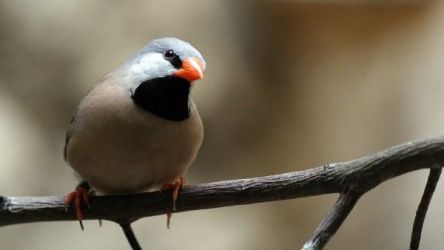
I didn’t live close enough to any rivers for otters to be a problem, so I didn’t worry about them. Opposums, muscrats, beavers, turtles, and foxes were also possibilities, but I had not heard of any in the area. I often heard coyotes in the night, filling the sky with their songs. I have seen bears, as well, even on our deck, but I built a six-foot fence and it serves as a deterrent to most nocturnal visitors. For various reasons, those suspects all lacked opportunity.
Cats were also known to engage in the criminal enterprise of stealing pond goldfish. My daughter’s cat, though, is elderly and arthritic, so she was probably not physically able to commit this crime. I used to have occasional strays wander through, but ever since I built that fence, I had not seen any in my yard. It did not seem likely that any cats would have had the opportunity to do the deed.
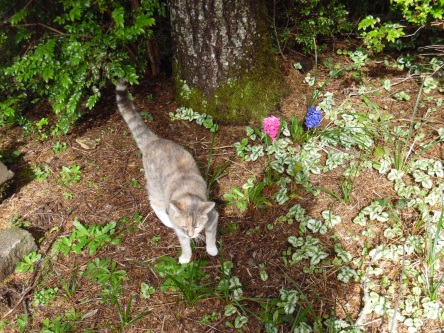
Great Blue Herons were prime suspects, with their long rap sheet listing assaults on backyard ponds There were plenty of herons in the area, too, because their fall semi-migration meant the numbers had increased dramatically. Instead of seeing the occasional heron, I had been seeing groups of six or eight. Herons were able to clean out much bigger ponds than mine, because their long bills provided an excellent murder weapon. Still, the ponds were very close to the house, in small spaces that made a heron, with its six-foot wingspan, an unlikely visitor. Reluctantly, I scratched the Blue Heron off my suspect list

My first thought had actually been raccoons, because I had once seen one in the pond. They had the opportunity, because although I had fenced the property, I knew it was almost impossible to keep raccoons out of–well, anywhere. Goldfish in a pond would be a lovely snack for them, without too much work.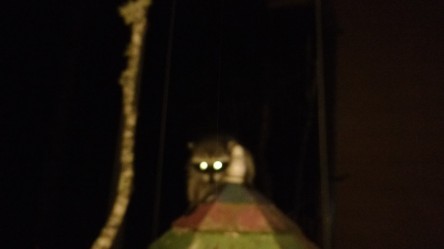
The most surprising pond predator I ever saw was a garter snake. My daughter and I watched one day as a snake hovered, its body on the ground beside the pond, its head swaying just above the water. We were startled when it suddenly struck at the water–but not as surprised as the goldfish it carried away into the bushes to digest.
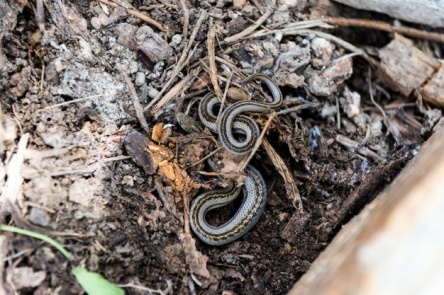
The most likely suspects, it seemed to me, were raccoons and snakes. Both had motive, means, and opportunity. With my suspect list narrowed, I decided to set a trap. First, though, any new goldfish I bought to eat the mosquito larvae would need a safe house.
There were plenty of ideas for protecting goldfish. To compensate for my failures in pond design (at least where criminal assault was concerned) I decided to add some water plants so fish could hide under them. More plants surrounding the ponds also discouraged predators from approaching the water. Lilies and ornamental grasses would not shed many leaves into the pond, so I decided to plant those nearby.
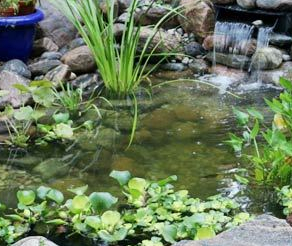
Having dogs was supposed to help protect ponds, but because of the number of bears in the area, leaving dogs outside at night was not recommended. Since the raccoons came at night, the dogs were not much help. After dark, they were safely tucked away in the house.
If I had money to spend, I could have bought motion detectors, and used them to set off sprinklers when anything approached the ponds. Some people have said they preferred to attach the motion detectors to radios or other noise makers, but the thought of sudden noises in the night was not appealing, especially because my ponds are so close to the house. There were also repellents available. Some of them smelled bad, so keeping the predators away might have meant keeping me away as well.
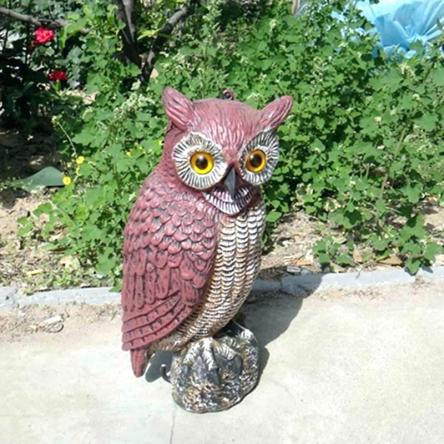
Buying decoys was another possibility, and I decided to keep my eyes open for possibilities. If I had still suspected herons, which were very territorial, having a decoy was supposed to keep the birds away. Statues of geese or swans had the same purpose, even convincing hungry herons to keep their distance. Alternatively, statues of larger prey animals, like alligators and even owls, were also supposed to be helpful. Maybe they would work for raccoons, as well as herons, as long as I moved them frequently enough to be effective. Like motion detectors, though, they cost money. Unless someone decided to leave decoys by the road for me to claim, I had to find another solution.
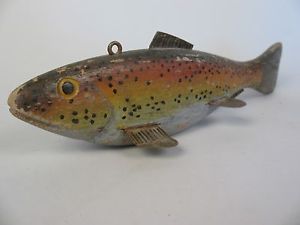
Oddly enough, some fellow pond-owners recommended actual decoy fish. They supposedly fooled predators, so when they snatched the decoy fish and found out it was inedible, they sometimes gave up. Even if they didn’t, the distraction allowed the real fish to swim away and hide. I decided to search my family’s fishing tackle collection and see if there were any lures that would work as decoys–after I removed the hooks, of course. I wanted to chase the predators away, but I didn’t want to kill or injure them.
I needed solutions I could afford, so I kept thinking. Because people in my area really did leave items they did not want by the road to be claimed, I had recently obtained some lengths of dark-colored 4″ sewer pipes. Cutting twelve-inch pieces, and laying them in the bottom of my ponds, was one way to provide safe houses for my fish. Heavy galvanized pipes, or ceramic pieces, might have been even better. Some people have used ceramic flower pots, placed on their sides or propped upside down, in the same way. Flat rocks, set up so there was space underneath, had protected some of my little fish from predators, so I decided to add more of those to each pond. In my biggest pond, I considered building a a small cage made of rigid mesh like hardware cloth, into which the fish could swim for safety when a predator was around.
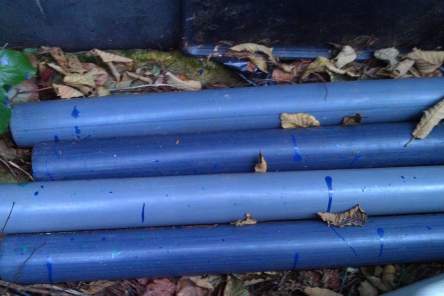
When I saw the raccoon enjoying the first pond I built, shortly after I moved here, I solved the problem by stretching plastic bird netting a few inches above the pond. I weighted it down at the sides with rocks, and tucked the edges securely away. That worked, and kept leaves out of the pond, as well. It wasn’t very attractive, though, and I removed it in the summer. My mistake was in not putting it back later. Stretching piano wire or fishing line across the top of the pond in a random criss-cross pattern was another way to accomplish the same thing, but it had more risk of injuring the small finches and other songbirds that enjoyed splashing in the water at the edge of the ponds.

If garter snakes were the culprits, though, bird netting might not help. Many garter snakes would be able to slide right through the netting, or get under the edges. I decided to try netting, and if I still lost goldfish, I would assume the snakes were responsible. In that case, window screen would probably be the only other option.
For now, I will take all of the steps I can, including plants, netting, and decoys. I will keep the pond covered through the fall and winter months, and even through the spring. In the summer, though, I will take the netting off so I can can enjoy watching my fish, and the little birds that bathe at the edges of the ponds. For the greatest success, I have learned that I need to change tactics occasionally, so I will use the netting for a while, and then any decoys I have found, and I will move those frequently. I want to keep my little goldfish ponds stocked, and I will find simple, low-cost ways of doing so–because I want to watch the goldfish swimming by.
I like how you practice problem-solving skills with this project. 🙂
LikeLike